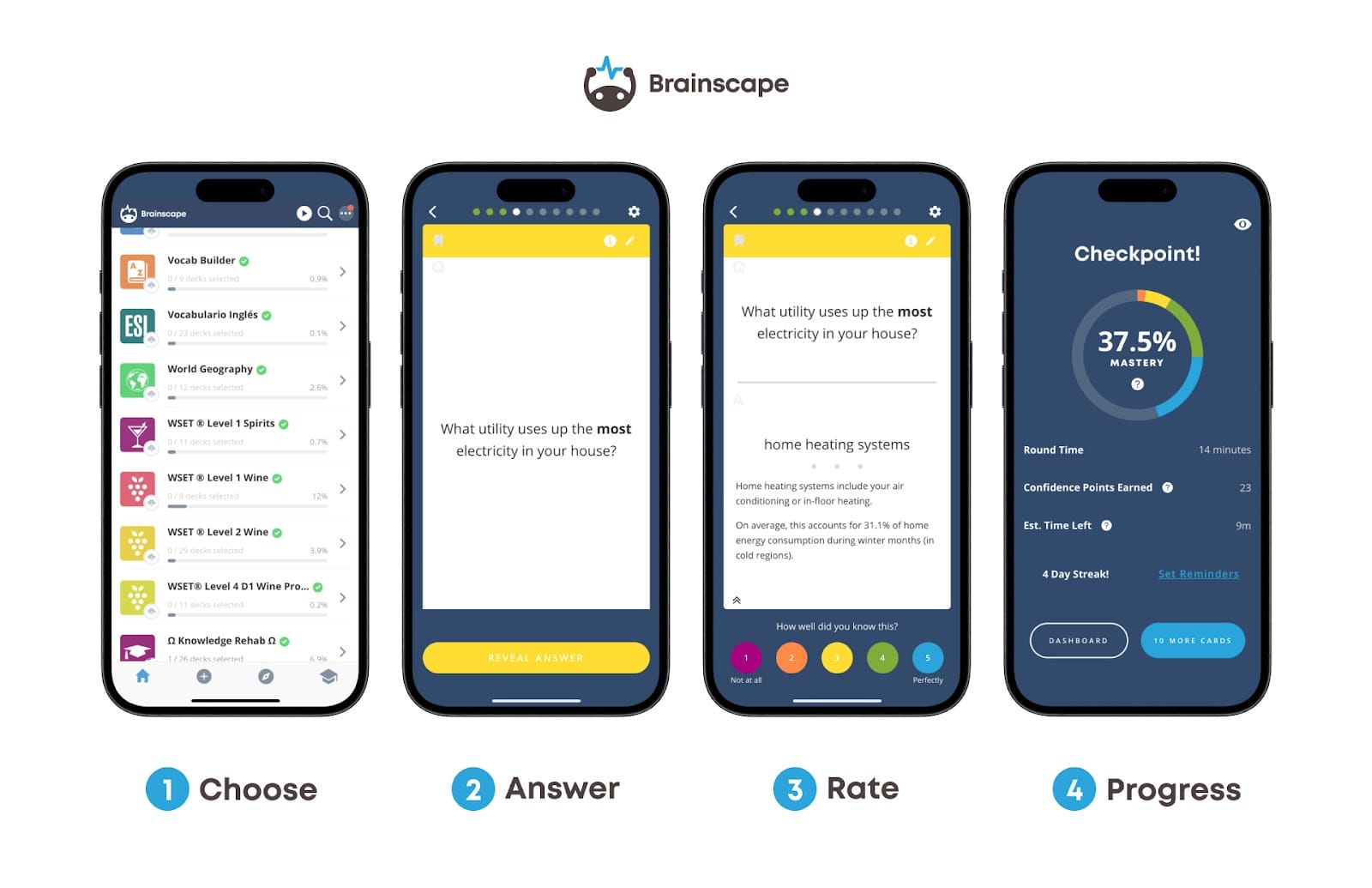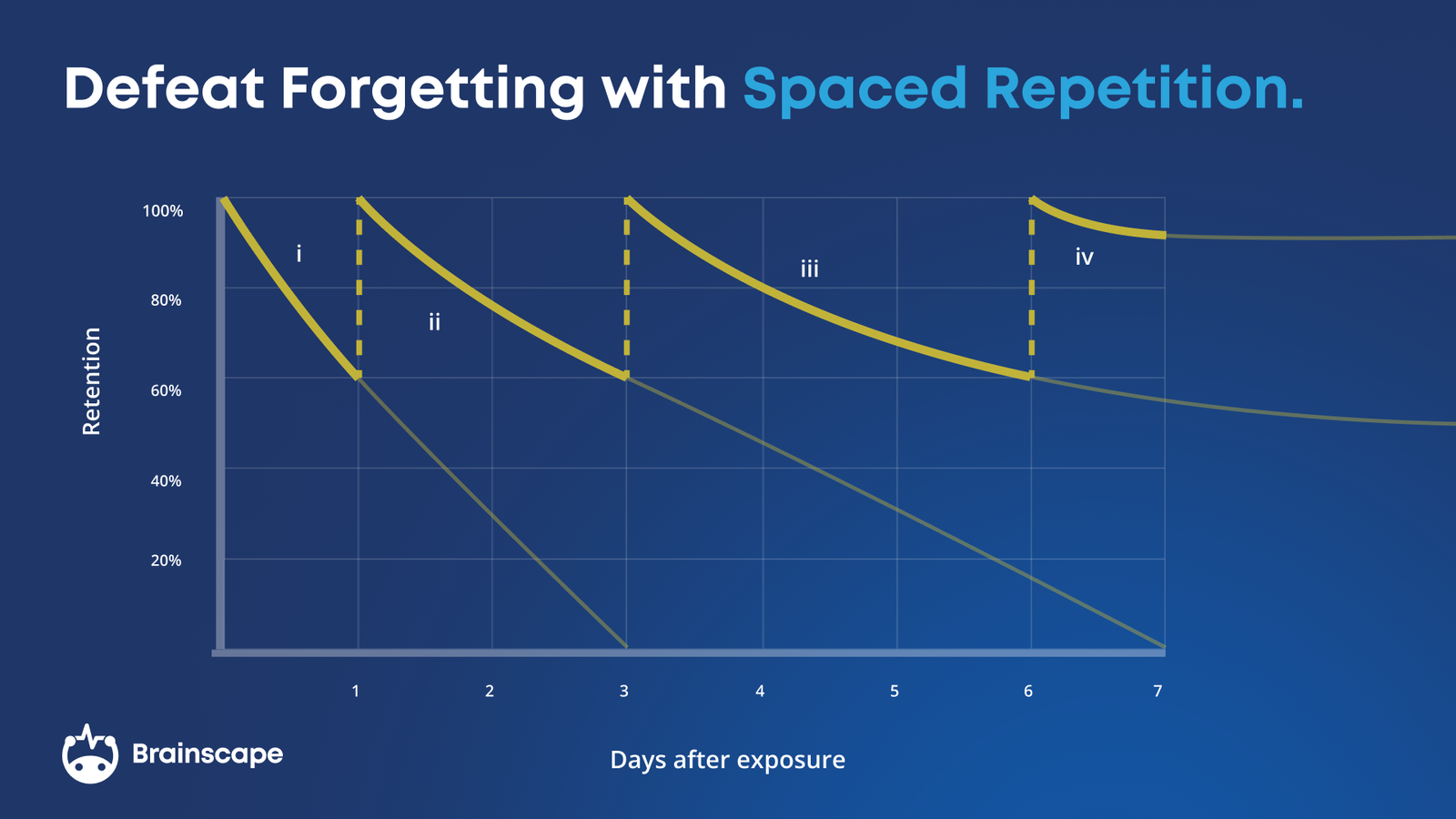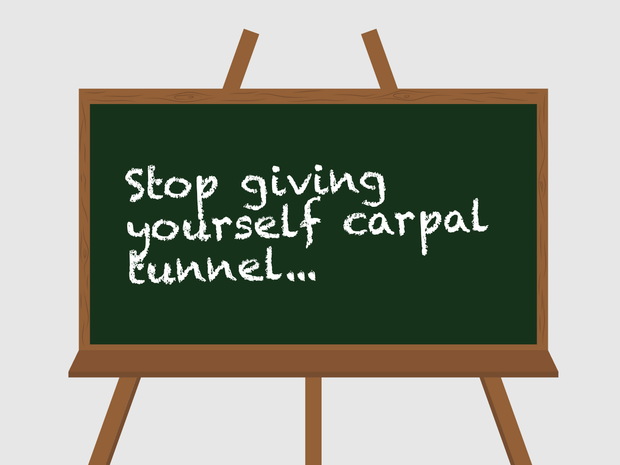It’s a race against time, and you're doing it wrong.
The projector’s beam sears the canvas. The lecturer paces, PowerPoint clicker clutched in hand, words streaming from their mouth faster than you can follow, accompanied by a furious symphony of scribbling and tapping from your fellow students, bent low to pages and keyboards.
The clock is ticking.
Sweat beads across your forehead. The slide has been up for a whole minute now. Any second, that clicker will rise and skip to the next slide. But you’re not done yet. Your knuckles whiten, pen screaming across the page. Almost finished ... almos—CLICK!
“And as we see on this next slide”
Noooooooo!
We put so much pressure on ourselves to take good notes: to capture everything our educators show us and tell us that we forget to do the most important thing of all:
Hear what they are saying.
The result is that you walk out of the classroom with next to NO recollection of the lesson.
Sure, you’ll have your notes (written by a spider that fell in an inkwell and floundered across the page), but you’ll only look at those again when the next test or exam comes your way. And by that point, you’ll struggle to make head or tail of them.
We’re here to change that.
The team here at Brainscape has spent over a decade rigorously asking ourselves, the scientific literature, and our millions of users what it takes to learn as fast as humanly possible. Our discoveries have become the foundation and framework of our web and mobile flashcard app, which applies proven cognitive learning principles to help anyone of any age learn so much faster for any subject, language, or exam.
It has also taught us that note-taking is one of the primary tenets of education. Note-taking can vastly improve student learning. Yet, most students have been doing it wrong.
This doesn’t have to be the case.
By taking your focus off the notebook in front of you and returning your attention to your lecturer, you can spend more time learning in class and less time relearning everything from scratch when exam time comes.
With that, here's how to take notes well (and how not to)...
The Secret for How to Take Notes Well: Preparation
As students, we think the best way to take notes in class is to be thorough. The more, the better. But the tragedy is, for all your efforts, this way of recording information is just not benefiting you as it should. In fact, the opposite is true.
While you’re so busy writing everything down, you’re missing out on:
- Engaging in the lecture,
- Hearing what your teacher is saying,
- Processing the information, and
- Asking questions about what’s unclear to you.
This is what genuine learning looks like: listening and engaging in class. The missing link in facilitating this ... is preparation.
Preparing for class beforehand is a fundamental step that almost all students are missing in their note-taking approach.
Okay, so nobody actually reads the textbook before class. But you can!
The ironic secret to taking better notes isn't as much what you do in class as what you do before it.
Reading the relevant section or chapter before class:
- Fundamentally takes the pressure off of you to write everything down during the lecture,
- Alerts you to what information is to come, which primes your brain for learning,
- Contributes enormously towards your ability to understand the information presented in the lecture,
- Frees up your concentration and focus, which you can now direct at the lecturer and to asking questions,
- Deepens the memories you make of the information, and
- Saves you hours of time later on.
With this preparation done, you can walk into class primed to learn and fully equipped to sit back, listen, engage, and only take notes when needed. Keep reading for a step-by-step on how to best prepare for class.
Use These 8 Steps to Take Better Notes
“By failing to prepare, you are preparing to fail.” ― Benjamin Franklin (and he’s on the $100 bill so he knows what he’s talking about)

We have 8 steps for effective note-taking strategies. The first four steps are all about how to best prepare and make the most out of your class:
- Step 1: Review the previous lesson
- Step 2: Read through the new material
- Step 3: Write down any questions you might have
- Step 4: Make preliminary notes before class
Step 1. Review the Previous Lesson
In most subjects, the concepts you learn today logically support the concepts you learn tomorrow. If you don’t know what the heck is going on, anything new you’re exposed to isn’t going to have a framework to fit into, which makes remembering it so much harder.
Ergo, by reviewing the previous lesson’s notes, you (1) reinforce the information you learned (which is critically important) and (2) provide a stable foundation for the new information you’ll be exposed to today.
It’s exactly like the "previously on" recap at the start of a TV episode.
Step 2. Skim Through the New Material
Being primed to learn makes your brain receptive to new information. So, read through the sections your lecturer intends to cover in the next lesson before you arrive for class.
Reading ahead in the textbook takes new information you need time to process and makes it familiar. Then, in class, you can focus on consolidating that information and filling in the gaps.
This may feel super nerdy. Who reads the textbook before class? But think about it. You're gonna have to read the chapter anyway. If reading it before the lecture is so much more effective, why not do it in this order?!
The idea here is not to memorize or become 100% confident in the material but rather to establish:
- A high-level view of what’s to come,
- A preliminary understanding of the chapter’s key concepts, and
- An idea of the concepts you might struggle with.
It also makes you curious to fill in the gaps ... and a curious student is an engaged student!
Step 3. Write Down Any Questions You Might Have
Once you’ve finished reading the chapter, think about some questions you should ask to bridge any gaps in your understanding.
For example: let’s say you’ve read a chapter on thunderstorms, and you mostly understand the atmospheric requirements for their formation. But cloud electrification has you more confused than a baby boomer with an iPhone. You might write the following questions:
- How do particles within a cloud become positively and negatively charged?
- Why do the positive ions travel upward while the negative ions travel earthward?
- Do people who play golf in thunderstorms have a lower-than-average IQ?
Simply jotting these specific questions down awakens your powers of metacognition.
Oooh, aaah.
Metacognition is your awareness and understanding of your own thought processes, and using it prompts your brain to form deeper memory traces.
In your head, it might sound a little like this: “Do I fully understand this concept? Or could I use some clarity on a few points?”
This type of inquiry encourages engagement in class and puts your brain into problem-solving mode, both of which are powerful for learning and remembering. And this takes the pressure off the note-taking in class, since you’ll already know the information your lecturer will be presenting.
Step 4. Make Preliminary Notes Before Class
Now, your task is to create your own chapter outline with preliminary notes from the textbook. The idea is to have the basic structure of the chapter with its main concepts laid out in logical connection with one another, leaving plenty of space for you to write down additional information in class.
Keep this summary succinct and include only the key points, concepts, and definitions from the chapter. This should only take a few minutes! Anything longer is probably going to deter you from doing this all-important prep work, so keep it concise.
With your preparation done, we will now address how to take good notes during and after class with the following four steps …
- Step 5: Note-taking in class
- Step 6: Consolidate the material
- Step 7: Transform the salient concepts into flashcards
- Step 8: Reframing content as concept maps
Step 5. Note-Taking in Class
With your preliminary notes done, you can focus on the lecture, using the spaces you’ve left to flesh out the information rather than writing everything from scratch.
Use a highlighter or a star in the margin to mark the most important points so that you can turn these into flashcards later (more on this in a moment!).
Pro Tip: If the information in a particular lecture is super important and unfamiliar, you could even use your phone to record it. This frees you up to pay total attention in class rather than writing down notes.
But be SUPER sparing with this technique. It has the nasty habit of making students lazy and seducing them to put off the necessary preparation and consolidation work until right before the exam. It can also be time-consuming working through 23 hours of audio/video content! Like people who take videos of fireworks displays, you might both miss the moment and then never look at the video again.
Step 6. Consolidate the Material
Before the lecture (with your preparation work), you were introduced to the chapter’s concepts for the first time. During the lecture, these concepts were reinforced and expanded upon. Now, after the lecture—ideally within 24 hours of it—you should sit down with your notes and combine everything you have into Version 2.0: your new, improved, and rewritten sexy study notes!
This consolidation of your study notes after class strengthens the memory traces you’ve created in your brain while also helping you to understand the section’s most important concepts and paraphrase them in your own words. It also leaves you with a valuable learning asset, which you can use for studying for tests and exams!
Step 7. Transform the Salient Concepts into Flashcards

What you really need to do after taking notes is to transform them into a format that you can actively study later. And this is best done by turning the material’s salient points into Cue/Target pairs (i.e. Question/Answer cards), which you can review in a custom pattern based on how well you know each one.
That’s right: we’re talking about flashcards. And, naturally, flashcards are Brainscape’s favorite study tool!
Flashcards have been used for centuries by serious students to efficiently learn knowledge-intensive subjects, from biology, science, and medicine to history, law, language, and physics...

What flashcards essentially do is break subjects up into their fundamental (and manageable) bite-sized facts, making them much easier to digest. They also leverage your brain's innate wiring to help you absorb information by engaging:
- Active recall: Thinking of the answer from scratch rather than passively reading through your notes or textbook,
- Spaced repetition: Repeating your exposure to the information in order to better memorize it.

- Metacognition: Assessing the strength of your knowledge as you go.
Decades of cognitive science research and thousands of academic studies prove this method's effectiveness. Plus, our AI system turns your study notes into flashcards within minutes!
Just remember, no matter how great the flashcard tool you use—and Brainscape is pretty great—if you don't first record and consolidate your notes effectively, you may be missing the key content that’s likely to be on your exam!
Step 8. Reframing Content as Concept Maps
Finally, if your subject is riddled with complex, interrelated topics, you can display it on a mind map or concept map. These allow you to focus on connections and understand the subject as a whole.
BUT while concept maps are great exercises to consolidate notes after the lecture, they are not the best format for studying that information later on. Similar to reading a textbook, simply staring at a concept map only engages your brain on a passive level and doesn’t establish any strong, meaningful connections to that information. This tends to form shallow memories that disappear quickly.
Flashcards, on the other hand, compel you to actively recall information (by answering questions) and repeat difficult concepts to you more often, which, as we have explained, establishes deeper memory traces.
So, be cautioned: making concept maps can be a useful tool, but if you think that continually reviewing them will help you prepare effectively for your exam, you might be making a version of the #1 biggest studying mistake!
What About the Cornell Method of Note-Taking?
Most resources that dive into how to take good notes mention the “Cornell Method”: a systematic format for condensing and organizing notes designed for high school or college level students. Very briefly, the Cornell Method pivots on the same approach we have discussed in this article (record, question, recite, reflect, and review) but requires students to divide their page into two columns with keywords and questions on the left and discussion on the right.
You can also combine this with the visual icons for deeper learning.
The Outline Method is another popular note-taking strategy (also for college-level students). An outline naturally organizes the information in a highly structured, logical manner, forming a skeleton of the subject. This can later serve as an excellent study guide when preparing for exams.
Which note-taking method works the best? Quite simply: the one that works for you. It's worth experimenting with a few different methods, then sticking to the one that you find easiest.
How to Make Good Study Notes: a Summary
Now you know how to take notes the right way, follow these steps:
- Step 1: Review what you learned the day before
- Step 2: Skim-read through the new material
- Step 3: Write down any questions you might have
- Step 4: Make preliminary notes before class
- Step 5: Only write down new information in class (and ask questions if you're unsure of anything)
- Step 6: Consolidate the material
- Step 7: Transform the salient concepts into flashcards
- Step 8: Reframe content as concept maps, if necessary
All of this—the pre-reading, preliminary note-taking, jotting down of questions, information consolidation, and flashcard-making—may sound like a lot of extra work.
It’s not.
It is the work you should be doing to (1) truly master your subject, (2) prepare for your exams throughout the semester, and (3) save yourself hours of study time later on, not to mention the anxiety that comes with cramming an entire semester’s worth of information into a few days or weeks.
The note-taking approach we have outlined in this guide sets the excellent students apart from the mediocre ones. Plus, by spending a few minutes before the lecture, you save yourself days of work later in the semester. So, go forth and study smarter with our eight steps on how to take good notes!
Additional Reading
- How to create a study routine that maximizes productivity
- How to Build Strong Study Habits
- Are Flashcards Effective for Studying?
Sources
Chang, W. & Ku, Y. (2014). The effects of note-taking skills instruction on elementary students’ reading. The Journal of Educational Research, 108(4), 278–291. https://doi.org/10.1080/00220671.2014.886175
Cornell University. (2024). The Cornell Note Taking System. Learning Strategies Center. https://lsc.cornell.edu/how-to-study/taking-notes/cornell-note-taking-system/
Kiewra, K. A. (2002). How classroom teachers can help students learn and teach them how to learn. Theory Into Practice, Digital/Theory Into Practice, 41(2), 71–80. https://doi.org/10.1207/s15430421tip4102_3
Marinelli, J. P., Hwa, T. P., Lohse, C. M., & Carlson, M. L. (2022a). Harnessing the power of spaced repetition learning and active recall for trainee education in otolaryngology. American Journal of Otolaryngology, 43(5), 103495. https://doi.org/10.1016/j.amjoto.2022.103495
UNC-Chapel Hill Learning Center. (2024a, February 19). Effective Note-Taking in class – learning center. Learning Center. https://learningcenter.unc.edu/tips-and-tools/effective-note-taking-in-class/#:~:text=Good%20note%2Dtaking%20will%20improve,what%20you%20hear%20and%20see.
UNC-Chapel Hill Learning Center. (2024b, February 19). Taking notes while reading – Learning Center. Learning Center. https://learningcenter.unc.edu/tips-and-tools/taking-notes-while-reading/
Wong, L. (2006). Outlining method for note taking [Book]. Houghton Mifflin. https://www.missouristate.edu/BusAdv/_Files/p-24.pdf
